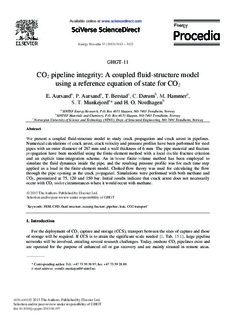| dc.contributor.author | Aursand, Eskil | |
| dc.contributor.author | Aursand, Peder | |
| dc.contributor.author | Berstad, Torodd | |
| dc.contributor.author | Dørum, Cato | |
| dc.contributor.author | Hammer, Morten | |
| dc.contributor.author | Munkejord, Svend Tollak | |
| dc.contributor.author | Nordhagen, Håkon Ottar | |
| dc.date.accessioned | 2017-12-19T09:48:55Z | |
| dc.date.available | 2017-12-19T09:48:55Z | |
| dc.date.created | 2013-08-20T16:22:24Z | |
| dc.date.issued | 2013 | |
| dc.identifier.citation | Energy Procedia. 2013, 37 3113-3122. | nb_NO |
| dc.identifier.issn | 1876-6102 | |
| dc.identifier.uri | http://hdl.handle.net/11250/2472773 | |
| dc.description.abstract | We present a coupled fluid-structure model to study crack propagation and crack arrest in pipelines. Numerical calculations of crack arrest, crack velocity and pressure profiles have been performed for steel pipes with an outer diameter of 267 mm and a wall thickness of 6 mm. The pipe material and fracture propagation have been modelled using the finite-element method with a local ductile fracture criterion and an explicit time-integration scheme. An in-house finite-volume method has been employed to simulate the fluid dynamics inside the pipe, and the resulting pressure profile was for each time step applied as a load in the finite-element model. Choked-flow theory was used for calculating the flow through the pipe opening as the crack propagated. Simulations were performed with both methane and CO2, pressurized at 75, 120 and 150 bar. Initial results indicate that crack arrest does not necessarily occur with CO2 under circumstances where it would occur with methane. | nb_NO |
| dc.language.iso | eng | nb_NO |
| dc.publisher | Elsevier | nb_NO |
| dc.rights | Attribution-NonCommercial-NoDerivatives 4.0 Internasjonal | * |
| dc.rights.uri | http://creativecommons.org/licenses/by-nc-nd/4.0/deed.no | * |
| dc.title | CO2 pipeline integrity: A coupled fluid-structure model using a reference equation of state for CO2 | nb_NO |
| dc.type | Journal article | nb_NO |
| dc.type | Peer reviewed | nb_NO |
| dc.description.version | publishedVersion | nb_NO |
| dc.source.pagenumber | 3113-3122 | nb_NO |
| dc.source.volume | 37 | nb_NO |
| dc.source.journal | Energy Procedia | nb_NO |
| dc.identifier.doi | 10.1016/j.egypro.2013.06.197 | |
| dc.identifier.cristin | 1044233 | |
| dc.relation.project | Egen institusjon: 16X89331 | nb_NO |
| dc.relation.project | Norges forskningsråd: 193816 | nb_NO |
| dc.description.localcode | © 2013 The Authors. Published by Elsevier Ltd. Open access under CC BY-NC-ND license (https://creativecommons.org/licenses/by-nc-nd/3.0/) | nb_NO |
| cristin.unitcode | 194,64,45,0 | |
| cristin.unitname | Institutt for konstruksjonsteknikk | |
| cristin.ispublished | true | |
| cristin.fulltext | original | |
| cristin.qualitycode | 1 | |

